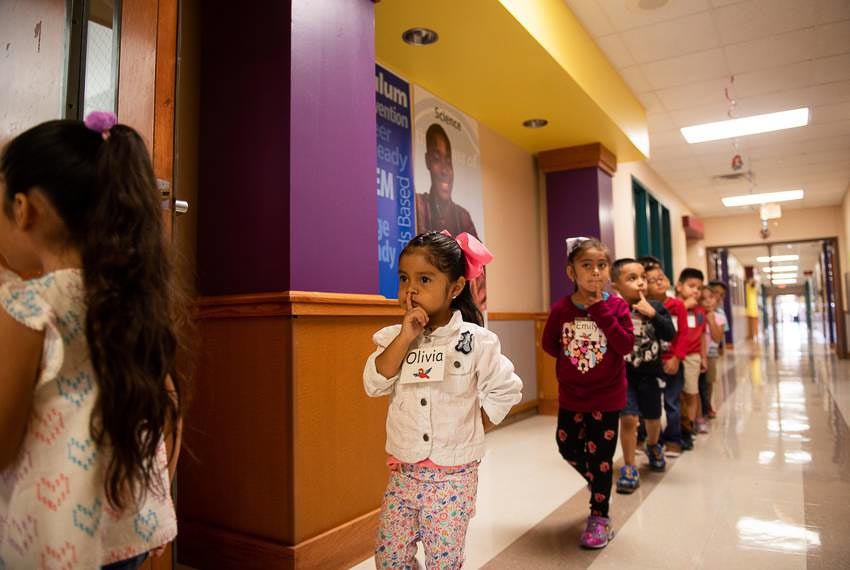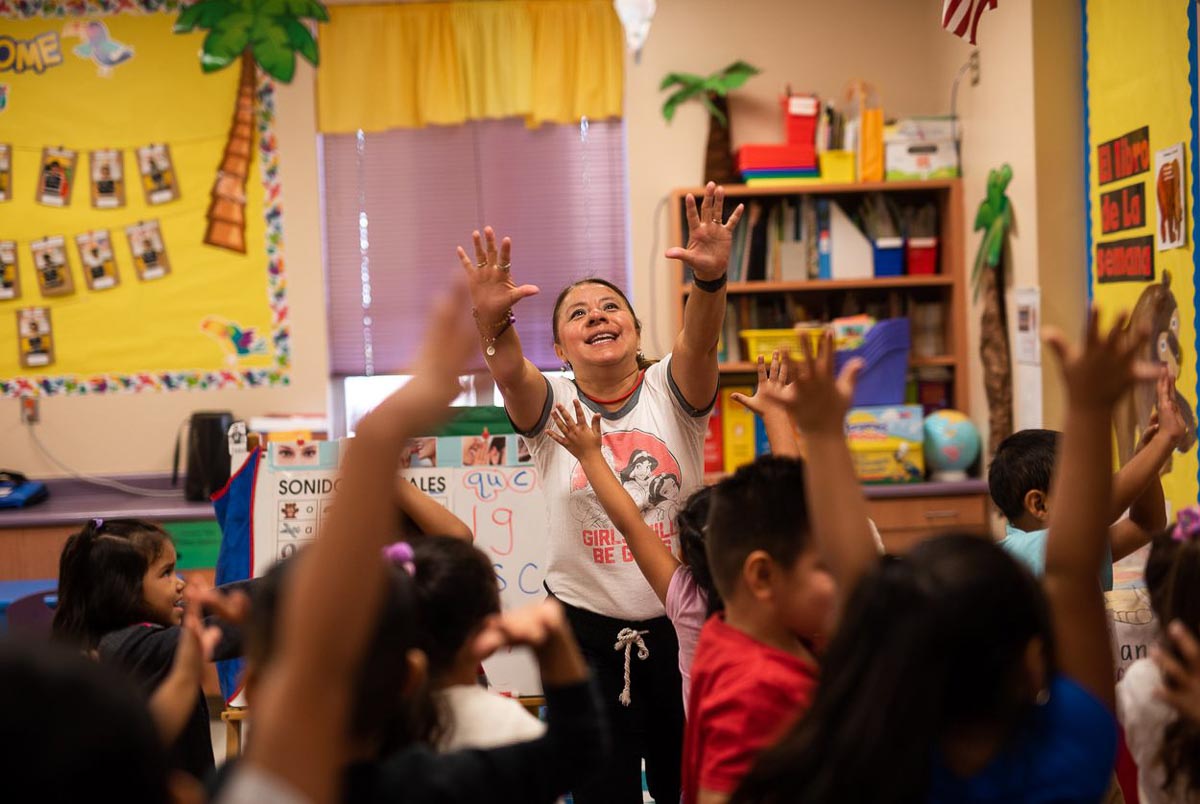KYLE — Hemphill Elementary School teacher Jo Ann Zavala knew exactly how many students sat on the multicolored rug in her bilingual pre-K class last Thursday, because she had them count themselves that morning.
Many of the 17 wriggling 4-year-olds in Zavala's Hays Consolidated Independent School District classroom hesitated before bellowing each number, attempting to follow their teacher's lead. Zavala, a 23-year teaching veteran with a surprising amount of energy, knew that by the end of the school year, many would be able to recognize the numbers on their own, without her enthusiastic encouragement.
"Most start with nothing," she said. "As a bilingual teacher, I know there's an urgency."
This is the first year the Central Texas school district has offered free, full-day pre-K for eligible 4-year-olds in 12 of Hays CISD's 14 elementary schools, thanks to more money and a mandate from a new state school funding law. Although studies show quality full-day pre-K contributes to significant gains in student literacy and math skills, Texas had previously only funded half-day pre-K for kids who are low-income, homeless, in foster care or English learners, or who had parents in the military.
In Hemphill Elementary and across the state, the majority of kids enrolled in state-funded pre-K are Hispanic and low-income, previewing how the demographics of Texas schools will continue to shift. Thousands of eligible 4-year-olds in Texas are not enrolled in free state pre-K; the move to full-day pre-K is intended to help as a better option for parents who can't afford to leave work midday.
While Hays CISD has made major inroads in implementing full-day pre-K, the story isn't the same for many other districts in the first school year after the new law passed. With just a few short months between the end of the legislative session and the first day of school, administrators had to tackle a catalogue of challenging tasks: hire enough teachers to meet spiking enrollment numbers, advertise the new options to parents living in district boundaries, consider transportation options, and make space in existing elementary schools or portable buildings.
That was too much too soon for Frisco ISD, one of multiple school districts that could ask for a temporary waiver from offering full-day pre-K this year, because it doesn't have enough space for extra classrooms. The law allows districts to apply for a waiver for up to three years, but those applications are not due until later this academic year.
Administrators for Frisco ISD, one of the fastest-growing school districts in the state, are using this year to figure out how to find classrooms outside of the single building that is used for students in half-day pre-K.
"We're looking at other campuses across the district that might have space and looking at the most efficient way to use that across the district," said Melissa Ellis, assistant director of early childhood. "It wasn't an easy like, 'Oh, we have all these empty classrooms. We're just going to use them up.'"
Lawmakers and advocates have encouraged school districts to partner with federal and private providers, including Head Start and local child care organizations, to increase the number of students they can serve and guarantee high-quality programs.
That's an option Frisco ISD is looking into, but many area child care centers have reached capacity or would struggle to meet the state requirements for running a pre-K program, said Daniel Stockton, Frisco ISD's executive director of government and legal affairs. Those requirements include using certain curricula, keeping the student-teacher ratio low and pledging to report student progress to the state — standards that Gov. Greg Abbott has championed although he has previously failed to secure the funding for school districts to be able to comply.
"There's no question that maximizing every possible early childhood funding source is going to help communities deliver more effective early education programs to more families," said Stephanie Rubin, CEO of the nonprofit Texans Care for Children.
More time for learning
Hays CISD Superintendent Eric Wright was planning to extend the district pre-K program to a full day this year with or without a state mandate. Without the extra state money, projected to be about $1.8 million, he'd have been able to pilot full-day pre-K in just two high-needs elementary schools, extending the day for 200 of 500 students.
Now, 12 of 14 elementary schools serve 702 students in full-day pre-K classrooms. The additional hours allow teachers more time to instruct kids in reading and math. It takes more time than expected to lead a train of 4-year-olds to the cafeteria or bathroom and back to the classroom.
“You close a lot of the gaps before they actually occur,” Wright said. “A lot of our kids who haven’t been exposed to the cultural capital of academic literacy are the ones who are generally behind.”

It takes more time than expected to lead a train of 4-year-olds to the cafeteria or bathroom and back to the classroom. Eddie Gaspar/The Texas Tribune
At Hemphill Elementary School, where just 38% of students can read at grade level, pre-K parents already report seeing progress for their children after just a few weeks.
“I’ve seen a lot of change in him,” Maida De Leon said, in Spanish, of her 4-year-old son. “He’s interested in books, he’s starting to socialize with his friends when before he wasn't as social.”
Although it would be challenging, she would still have put him in a half-day program, eager to get him ready for kindergarten in a way she wouldn’t be able to do herself. De Leon works as a housekeeper, and she’s relieved to not have to pay for a babysitter or child care.
Zavala’s classroom is full of 4-year-olds like De Leon’s son. By 9 a.m. last Thursday, they’d counted from 0 to 17, nailed down the day of the week (jueves) and yelled out all the letters in the alphabet in Spanish. They also take electives — music, science, art and gym — that rotate every other day and couldn't be squeezed into a half-day program. In past years, Zavala was creative about fitting all her instruction into half a day, but she knows certain subjects, like math, suffered without the time.
Down the corridor from Zavala’s class, a classroom of 3-year-olds engaged in what appeared more like supervised play than structured learning. For the first time this year, Hays CISD is also educating 83 3-year-olds through a federal Head Start grant in partnership with Community Action of Central Texas. Previously, the Head Start program enrolled mostly 4-year-olds, but the new state funding allowed the district to use the federal grant more creatively.
Administrators are hoping to enroll 153 3-year-olds by the end of the year, after undertaking renovations to make more space, said Suad Hooper, Head Start program director.
Head Start has stricter requirements than state-funded pre-K; for example, a family of four must make less than $26,000 to qualify under the income criteria, as opposed to $48,000. Head Start also offers services like adult education classes, free medical services, counseling and home visits for the families of its students.
Standing in her colorful classroom last week, Zavala reflected on the little she remembers from her time as a Head Start student in San Marcos, which she thinks is part of why she’s the only one of her siblings who graduated from college. As she got older, her dad told her to focus on education as a job while her older siblings worked in the fields to help support the family.
"Schooling absolutely made a difference," she said.
Many of Zavala's students this year don’t know any of their letters or numbers, in English or Spanish, or even how to grip a pencil. She stretches the limits of their attention spans by incorporating hands-on activities into the reading lessons. When they seemed perplexed by the mention of vinegar in a picture book, she had them waft the acrid smell from a bottle.
As the district continues to build more opportunities for its youngest learners earlier in their lives, she can only hope her incoming classes in future years will start even more prepared.
This story was first published by The Texas Tribune, a nonprofit, nonpartisan media organization that informs Texans — and engages with them — about public policy, politics, government and statewide issues.

